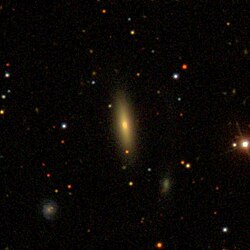
NGC 5821 is a spiral galaxy with a ring structure in the constellation Boötes. It lies near a similarly massed galaxy, NGC 5820, at the same redshift. Both galaxies were discovered by the astronomer William Herschel.
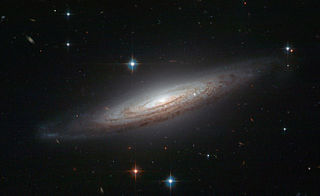
NGC 634 is a spiral galaxy, lying at a distance of 217.1 megalight-years away from the Milky Way in the northern constellation of Triangulum. This object was discovered in the nineteenth century by French astronomer Édouard Stephan. It is inclined by an angle of 82.4° to the line of sight from the Earth, and thus is being viewed nearly edge on.
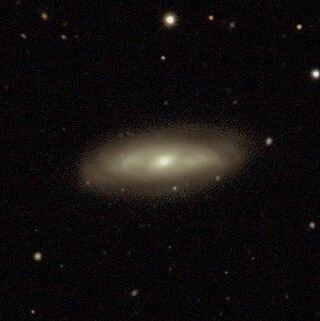
NGC 159 is a barred lenticular galaxy in the constellation Phoenix. The galaxy was discovered on October 28, 1834, by John Frederick William Herschel.

NGC 5030 is a barred spiral galaxy in the constellation Virgo. The object was discovered on 17 March 1881 by the American astronomer Edward Singleton Holden.

NGC 1683 is a spiral galaxy in the constellation Orion. The object was discovered in 1850 by the Irish astronomer William Parsons.

NGC 5201 is a spiral galaxy located in the constellation Ursa Major. It was discovered on April 14, 1789 by German-born British astronomer William Herschel. It is about 384 million light years away.

NGC 950 is a barred spiral galaxy in the constellation Cetus. It is approximately 205 million light-years away from the Solar System and has a diameter of about 85,000 light-years. The object was discovered in 1886 by American astronomer and mathematician Ormond Stone.
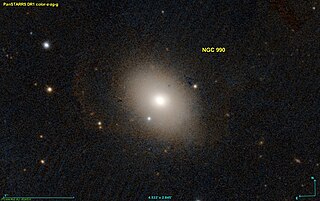
NGC 990 is an elliptical galaxy located in the constellation Aries about 153 million light-years from the Milky Way. It was discovered by the German - British astronomer William Herschel in 1786.

NGC 670 is a lenticular galaxy located in the Triangulum constellation about 165 million light years from the Milky Way. It was discovered by the German-British astronomer William Herschel in 1786.

NGC 790 is a lenticular galaxy in the constellation Cetus. It is estimated to be 233 million light-years from the Milky Way and has a diameter of approximately 90,000 light years. NGC 790 was discovered on September 10, 1785 by the German-British astronomer William Herschel.

NGC 904 is an elliptical galaxy in the constellation Aries. It is estimated to be 244 million light years from the Milky Way and has a diameter of approximately 85,000 ly. NGC 904 was discovered on 13 December 1884 by the astronomer Edouard Stephan.

NGC 906 is a barred spiral galaxy in the constellation Andromeda in the northern sky. It is estimated to be 215 million light years from the Milky Way and has a diameter of approximately 110,000 ly. NGC 906 was discovered on October 30, 1878 by astronomer Édouard Stephan.

NGC 996 is an elliptical galaxy of the Hubble type E0 in the constellation Andromeda. It is estimated to be 210 million light years from the Milky Way and has a diameter of approximately 75,000 ly. The supernova SN 1996bq occurred in this galaxy. NGC 996 was discovered on December 7, 1871 by astronomer Édouard Stephan.

NGC 706 is a spiral galaxy located in the Pisces constellation about 230 million light years from the Milky Way. It was discovered by the German–British astronomer William Herschel in 1786.

NGC 821 is an elliptical galaxy in the constellation Aries. It is estimated to be about 80 million light-years from the Milky Way and has a diameter of approximately 55,000 light years. NGC 821 was discovered on September 4, 1786, by astronomer Wilhelm Herschel.

NGC 736 is an elliptical galaxy in the constellation Triangulum. It is an estimated 200 million light years from the Milky Way and has a diameter of approximately 85,000 light years. NGC 736 was discovered on September 12, 1784 by the German-British astronomer William Herschel.

NGC 766 is an elliptical galaxy located in the Pisces constellation about 362 million light years from the Milky Way. It was discovered by British astronomer John Herschel in 1828.
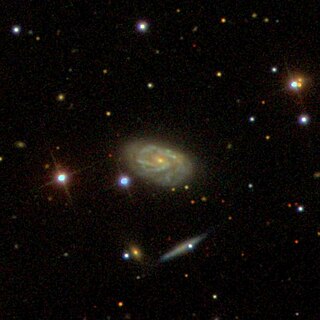
NGC 769 is a spiral galaxy located in the constellation Triangulum about 197 million light years from the Milky Way. It was discovered by the American astronomer Truman Safford in 1866.

NGC 623 is a large elliptical galaxy located in the Sculptor constellation at a distance of about 400 million light-years away from the Milky Way. It was discovered by British astronomer John Herschel in 1837.

NGC 861 is a spiral galaxy in the constellation Triangulum. It is estimated to be 360 million light-years from the Milky Way and has a diameter of approximately 165,000 light-years. The object was discovered on September 18, 1865 by Heinrich d'Arrest.
